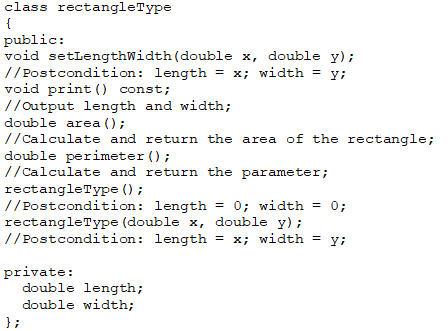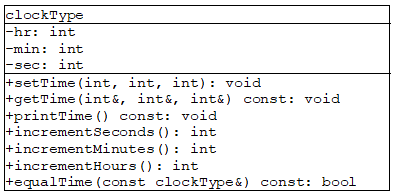A) .
B) ,
C) ::
D) #
F) B) and D)
Correct Answer

verified
Correct Answer
verified
Short Answer
A(n) ____________________ function of a class changes the values of the member variable(s) of the class.
Correct Answer

verified
Correct Answer
verified
Multiple Choice
A member function of a class that only accesses the value(s) of the data member(s) is called a(n) ____ function.
A) accessor
B) mutator
C) constructor
D) destructor
F) All of the above
Correct Answer

verified
Correct Answer
verified
True/False
Given this declaration: class myClass { public: void print(); //Output the value of x; MyClass(); private: int x; }; myClass myObject; The following statement is legal. myObject.x = 10;
B) False
Correct Answer

verified
Correct Answer
verified
Short Answer
If a class object is passed by ____________________, the contents of the member variables of the actual parameter are copied into the corresponding member variables of the formal parameter.
Correct Answer

verified
Correct Answer
verified
Multiple Choice
Which of the following is true about classes and structs?
A) By default, all members of a struct are public and all members of a class are private.
B) A struct variable is passed by value only, and a class variable is passed by reference only.
C) An assignment operator is allowed on class variables, but not on struct variables.
D) You cannot use the member access specifier private in a struct.
F) None of the above
Correct Answer

verified
Correct Answer
verified
Short Answer
A program or software that uses and manipulates the objects of a class is called a(n) ____________________ of that class.
Correct Answer

verified
Correct Answer
verified
Multiple Choice
A ____ sign in front of a member name on a UML diagram indicates that this member is a protected member.
A) +
B) -
C) #
D) $
F) All of the above
Correct Answer

verified
Correct Answer
verified
Multiple Choice
In C++, you can pass a variable by reference and still prevent the function from changing its value by using the keyword ____ in the formal parameter declaration.
A) automatic
B) private
C) static
D) const
F) All of the above
Correct Answer

verified
Correct Answer
verified
Short Answer
The header file is also known as the ____________________.
Correct Answer

verified
interface ...View Answer
Show Answer
Correct Answer
verified
View Answer
Multiple Choice
A ____ sign in front of a member name on a UML diagram indicates that this member is a public member.
A) +
B) -
C) #
D) $
F) None of the above
Correct Answer

verified
Correct Answer
verified
Multiple Choice
If a member of a class is ____, you cannot access it outside the class.
A) public
B) automatic
C) private
D) static
F) All of the above
Correct Answer

verified
Correct Answer
verified
True/False
If an object is created in a user program, then the object can access both the public and private members of the class.
B) False
Correct Answer

verified
Correct Answer
verified
Short Answer
With ____________________ functions, the definitions of the member functions are placed in the implementations file.
Correct Answer

verified
Correct Answer
verified
True/False
In C++ terminology, a class object is the same as a class instance.
B) False
Correct Answer

verified
Correct Answer
verified
Multiple Choice
 -Consider the accompanying class definition. Which of the following variable declarations is correct?
-Consider the accompanying class definition. Which of the following variable declarations is correct?
A) rectangle rectangleType;
B) class rectangleType rectangle;
C) rectangleType rectangle;
D) rectangle rectangleType.area;
F) B) and C)
Correct Answer

verified
Correct Answer
verified
Multiple Choice
 -Consider the UML class diagram shown in the accompanying figure. Which of the following is the name of the class?
-Consider the UML class diagram shown in the accompanying figure. Which of the following is the name of the class?
A) clock
B) clockType
C) Type
D) +clockType
F) None of the above
Correct Answer

verified
Correct Answer
verified
Multiple Choice
 -Consider the accompanying class definition, and the object declaration: rectangleType bigRect(14,10) ;
Which of the following statements is correct?
-Consider the accompanying class definition, and the object declaration: rectangleType bigRect(14,10) ;
Which of the following statements is correct?
A) bigRect.setLengthWidth() ;
B) bigRect.setLengthWidth(3.0, 2.0) ;
C) bigRect.length = 2.0;
D) bigRect.length = bigRect.width;
F) A) and C)
Correct Answer

verified
Correct Answer
verified
Multiple Choice
If a function of a class is static, it is declared in the class definition using the keyword static in its ____.
A) return type
B) parameters
C) heading
D) main function
F) B) and C)
Correct Answer

verified
Correct Answer
verified
Multiple Choice
A class object can be ____. That is, it can be created once, when the control reaches its declaration, and destroyed when the program terminates.
A) static
B) automatic
C) local
D) public
F) All of the above
Correct Answer

verified
Correct Answer
verified
Showing 21 - 40 of 43
Related Exams